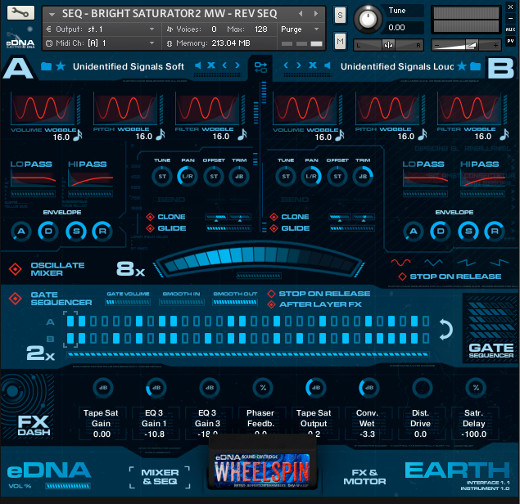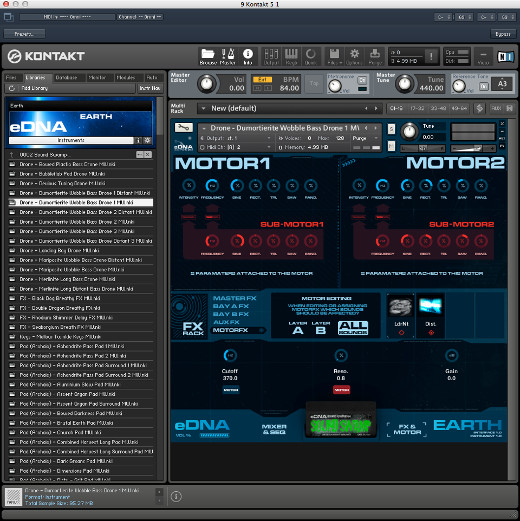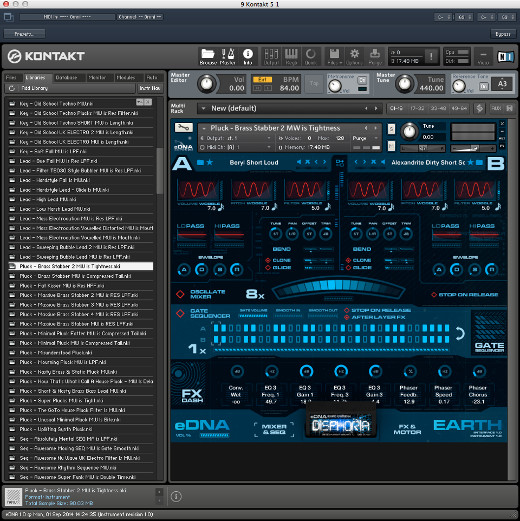Review: Spitfire eDNA01 – Earth – by Andrew Koss
For those of us that love music/sound synthesis, sound designing, and electronic production, we are living in glorious times indeed. We now have a vast ocean with a plentiful bounty to fill our synthesizer appetites. Every week it seems I’m reading yet another email or news article about a new virtual instrument.
It’s rare when one of these notifications catches my interest enough to check out the instrument, and far more rare when said instrument inspires me so much that I feel the need to pen a review. But this is what Spitfire Audio’s Electronic DNA, or eDNA, has done. In fact, not since Spectrasonics Omnisphere (arguably one of the best virtual instruments to date) have I felt so artistically inspired by a virtual instrument.
The folks who work on the more orchestral and cinematic side of music may be familiar with Spitfire Audio, but for those who aren’t, Spitfire has been creating top-tier virtual instruments for seven years. Helmed by composer/producer Christian Henson, who’s been successful in both film and contemporary music, Spitfire have concentrated nearly exclusively on orchestral and cinematic sounds.
They have created a vast array of beautiful instruments, played by renowned musicians, meticulously sampled in London concert halls and studios with only the best equipment. With libraries like Albion for large orchestral sounds, Sable for smaller chamber sized orchestras, and unique instruments like electric cello, plucked pianos, and even kitchen glassware, Spitfire has massed a massive collection, invaluable to composers and producers alike.
When I read that Spitfire decided to take this treasure trove and mangle, process, distort, reamp, and who knows what else, in the effort to create an entirely new sounding instrument, I couldn’t wait to get my hands on it.
Traveling to Earth
Phase One of eDNA, entitled Earth, is a massive collection of organic sounds that have been re-envisioned to create an instrument that caters to composers/producers of contemporary pop/electronic music, film and game composers, and most anyone else who enjoys lush and impactful sounds.
Earth is a Kontakt player instrument which consists of over 1900 recorded instruments used to create 1001 custom patches. Encompassing over 44 gigs, and over 34 hours of sampled audio, Earth is an ambitious undertaking. And while there is still room for improvement among the deeper features, Spitfire has presented an instrument that feels unique, insightful, and most importantly, musical. In their own words, “We’ve taken these orchestral recordings and have morphed them into the most incredible anthology of sonic weaponry from another time and place.”
Spitfire currently plans to develop three phases of this eDNA product line. When asked about the inspiration that birthed this project, Spitfire director, Christian Henson told me, “We’ve always played to our strengths so we thought, most valuable set of samples on the planet, excellent sound designers with excellent outboard, top-end script and GUI designers and a big team of editors that could make an undertaking of this sort possible.
‘We love our analogue synths, and we love our realistic V.I.s — this falls somewhere in between. I won’t call it hybrid because that has connotations on how it should be used. It’s just another way of making cool and complex sounds, it’s a once-in-a-generation opportunity so we took it.”
Layout
Earth organizes the massive preset library into several directories, each with their own sub-directories.
The Artist directory consists of six “cartridges” of sounds designed by various composers and producers. I’ve found I spend most of my time exploring these patches most often. The banks include Apocalypz, Disphoria, Moviedrome, Analoanaut, Discoman, and Sound Swamp.
Each cartridge attempts to focus the numerous patches into an overall general theme. This does help make browsing through the huge library a bit easier, but you’ll still find that plenty of patches in one cartridge that could easily apply to the implied genre of another. For instance, quite a few of the cinematic Moviedrome patches work brilliantly in a pop context. I found it helpful to mark and save patches that I found most intriguing into my own folders for future use as I encountered them.
The other large directory of carts is entitled Factory and this group contains all 1900+ vanilla instruments. The cartridges inside this collection consist of Warped Strings, Mutant winds, Synths, Alien Brass, Filth, and Esoteric. These collections of the raw samples allow you to mix and match samples to create your own patches.
For the users who really like to explore an instrument and create their own unique patches from the ground up, this area of Earth will keep them engaged for many hours.
The Instrument
Similarly to Omnisphere, at Earth’s core each patch consists of two different sound sources that can be blended together to create a more complex sound.
There is an A and a B sound bank, and each path runs through independent filters, modulation, gating, and then into bank-specific effects as well as master and auxiliary effects. Banks A and B have their own unique effects to choose from, which is intended to allow you to create distinctly different sounds between the two banks, that will play further play off each other as the two banks are blended. At times, this can feel slightly restrictive, but there’s still plenty to choose from in each bank and a button that swaps the sample in A to B and B to A.

This first image shows the updated version of Earth’s interface that is being released with version 1.1 available to all current users. The new improvements to the X-fader now allow for multiple wave forms as well as a “depth” control on either side of the slider.
Additionally there are master effects for the combined sound as well as aux effects that are sent from the individual channels and run parallel to the master. Spitfire also designed a second level of modulation controls that they’ve called “MotorFX”.
The MotorFX section is a complex but powerful modulation mechanism that allows the user to further modulate some of the effects that a patch is using. It offers two distinct “motors.” Each can be attached to one or several effects parameters in the patch. You can adjust the frequency to control the modulation rate, depth to adjust the amount of modulation, and then five waveforms including Sine, Rectangle, Triangle, Sawtooth, and Random.
Adding in amounts of each of the five waveforms create even more complex and warped waveforms. If that wasn’t enough, each motor has its own sub-motor which can modulate the frequency and depth of the motor itself.
At first glance, it’s a lot to wrap your head around, and even the Earth documentation struggles a bit to really explain this as clearly as one might like. In practical use though, the motor simply allows you to attach a modulator to one of the knobs of an effect, like the gain of the distortion effect, or the cutoff in a filter, allowing that parameter to have its own movement over time. Even small doses of this can create some wild and interesting sounds, and from there you can go into the sonically bizarre and strange.
Working with a patch
Loading up a preset you’re greeted with a very stylized interface skinned in a dark metallic blue. Most folks that have a general comfort level with other virtual instruments and synths should have no problem being able to get right to work exploring.
The top half of the instrument’s main panel is split down the middle separating the A and B banks. The six modulators (three per bank) are branded as “Wobble,” and they allow the user to modulate volume, pitch, and filters.
Below this are basic low and high pass filters with frequency and resonance control, a traditional ADSR amp envelope, controls for tuning, panning, key offset, gain, mono or polyphonic mode, pitch bend amounts and portamento control. There’s also a clone tool which adds a second voice that can be coarse or fine tuned allowing the user to add some harmony or fatten up the sound with a bit of detune. Next is the X-fader which we’ll expand on further in a moment.
Below that is a powerful rhythmic gate that with bank specific rhythms, gate volume, smoothing for the attack and release, and a user controllable (and automatable) pattern length. Finally at the bottom are effects parameters that you want quick access to, as well as the toggle to access the effects panel of the instrument.
Earth’s X-fader which looks like one part Knight Rider, and one part Battlestar Galactica Cylon, is a slider that allows you to sweep, slide, automate, oscillate, and blend the mix of sound A and B.
This conceptually simple idea of continuously controlling the balance of the two sounds provides a unique feel that is surprisingly powerful and engaging. You can set the tempo-locked oscillator to create a rapidly pulsing effect, or slow it down to evolve over numerous bars.

Here is the rear “panel” of Earth which gives users access to all of the available effects as well as the Motor system.
This can really get interesting when you begin to automate the rhythmic value of the oscillator creating even more variable tonality in your patch. There is a simple slider below the fader that allows you to set the start position of the fader and which direction it moves as it oscillates. You can also automate the fader’s movement yourself or set it in one place.
Another feature here that surprised me with its effectiveness was the “stop on release” which determines if the slider snaps back to its center point when you release the keys — or does it keep oscillating until the envelopes release has been reached and the sound has stopped.
The Feel
The interface is clean, well labeled, and straightforward. You can quickly explore the potential sonic landscape, and when you’re ready to go deeper with the patch you’re working with, you don’t have to struggle with the GUI just to get to the functions you’re looking for.
Spitfire has managed to fit a lot into a single Kontakt window. There are times this causes some things to feel a bit crammed in, and some of the controls can be tricky to grab with the mouse. There are inevitable limitations when having to work within Kontakt and the size of the GUI is a big one here. Another reality of a sample-based instrument are patch load times. On both our Mac Mini and our dual quad core Mac Pro, the load times varied but were never so slow as to feel interruptive or frustrating.
Earth does have some room for growth in the feature set front. The oscillators that control modulation in the wobble section are currently only sine waves. Other waveform choices would be a welcome option in this area. Also, when setting a bank to monophonic, there is no “legato” mode for the portamento. Automating the portamento time down for notes I didn’t want to slide was a simple enough work around in its current stage, but it still felt like an extra step. The step sequencer of the rhythmic gate doesn’t show a numerical count of how many steps you’re currently using, and having to count the squares to determine if you’ve got 18 or 20, is a bit tedious. On the flip side, I did create some pretty wild poly-rhythms by not restricting myself to a set number. Spitfire has commented that adding a numerical counter is a feature planned for an update in the near future.
The Sound
So often when working with Earth, I found myself saying, “I’ve never heard a patch quite like this before.” There’s a depth here that gives these electronic sounds a sense of breath and life that is rarely found in virtual instruments.
The libraries are loaded with useful and viable patches that feel like they belong and are not just there to inflate the size of the library. I’m a big fan of an instrument that can get me partially to what I’m looking for with one of the preset patches, and then give me enough control to allow me to develop the sound to meet my vision. Earth does this job very well.
With so many of Earth’s original sound sources coming from orchestral and cinematic applications, it’s not surprising that upon previewing many of the patches conjure up images from movies and video game environments. There are certainly patches in this library that would make the folks who work in scoring very excited about the possible applications. What’s interesting about Earth is how well these sounds not only fit into pop, dance, and other genres of music but how they enhance the music.
Music Example 1: This example shows how Earth can be used to a create a lush cinematic sound that is well suited for film, tv, and game scoring.
When asked about the sounds of Earth, Mr. Henson responded “There are presets in there I created whilst on holiday in Scotland with my family. We had this place that overlooked the Firth of Forth, a six month bout of insomnia proved beneficial for the eDNA-Earth project and many sounds were created with the sun rising above this beautiful body of water. I think you can hear that inspiration in some of the patches.”
That inspiration is undeniable. Earth’s pads and drones are simply exceptional. These range from stunningly beautiful to frightful and brooding. Perhaps it’s in these patches that the origin of these samples is allowed to shine, and the evolving qualities of the X-Fader work to create these remarkably lush and complex sounds.
I would not want to imply there is a shortfall in the lead, bass, keys, and other categories because they are all strong in their own right. A bass patch designed from thundering low pitched brass instruments has thunderous impact, and I came across a lead patch designed from clarinets that was smooth and melodic but cut through the mix like a knife through butter.
Music Example 2: In this example we explore how Earth’s sounds can be used in a Pop/EDM context. All synth sounds are generated by Earth with no other processing. Izotope’s BreakTweaker was used to create the drum loops.
More To Come
The team over at Spitfire was generous enough to give me a look at some upcoming changes and upgrades to Earth, and I was pleased to see some of my own initial criticisms were already being improved upon.
One example of this is the X-Fader’s oscillation abilities. Currently, if you use the oscillator to drive the fader, you can only use a sine wave and there is no ability to set a threshold of how far left and right from the center point the fader will go. There are plenty of times where the motion of the fader is wonderful, but you just don’t want to have moments of 100 percent bank A or 100 percent bank B. In the upcoming free update, you’ll be able to not only choose from multiple wave forms but set thresholds for both sides of the slider. Now you could have a slider that ranges from a 70/30 blend to a 20/80 blend. Or just set a narrow threshold and have the patch slightly morph between the two banks.
Additionally, the X-fader and gate sequencer can now go even faster and three more cartridges of patches are being added. This will give users 404 additional presets giving users over 3300+ to explore. I was given the opportunity to test out one of the new carts entitled Wheelspin which highlights just how much can be done with a spin of the mod-wheel. The sounds are increasingly intense, and you can hear a few of them in the demos throughout this review.
Video Scoring Demo: This short video is the opening sequence of a longer promotional video for the band “Awaken the Shadow.” Here the sounds of Earth were used to compliment orchestral sounds from Spitfire’s Albion 1 and Albion 3.
Conclusion
So do we call Earth a synth, a virtual instrument, or maybe something in between? We often use these terms interchangeably and sometimes labeling software like this, can give us preconceived notions on how it should be used.
I discussed this with Mr. Henson who left me with this thought, presented in the best Nigel Tufnel accent, “but this synth is made from Orchestras!” I’m going to say that for 149 British Pounds or 240 Dollars at the current exchange rate, the best thing to call Spitfire’s Earth is “a must have.”
Pro’s
• Massively large collection of organic, epic, emotional, and unique sounds.
• X-Fader provides a distinct and fun way to create new sounds that can move and evolve.
• Fantastic bang for your buck
Cons
• Some parameters can be a little hard to interact with in the GUI
• Imposed Limitations of Kontakt’s environment
Please note: When you buy products through links on this page, we may earn an affiliate commission.







